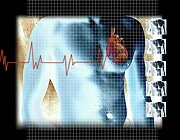
WEDNESDAY, June 25, 2014 (HealthDay News) — As many as four of every 10 stroke victims leave the hospital without a clue about what caused the stroke, their doctors hamstrung on how to prevent another one from occurring.
“You can imagine how unsettling this is,” said Dr. Rod Passman, a professor of cardiology and preventive medicine at Northwestern University. “Stroke is among the most feared events in medicine, and to leave the hospital with no clear cause and no directed therapy will weigh on any patient.”
But a pair of new studies has found that equipping patients with continuous heart monitors can root out one potential cause of these mystery strokes, a heart rhythm condition called atrial fibrillation.
Heart monitors either carried around by patients or implanted under their skin were able to detect atrial fibrillation in as many as 30 percent of those who had suffered a stroke of undetermined origin, said Passman, who co-authored the results of one of the clinical trials.
This discovery gave doctors an opportunity to further reduce patients’ risk of stroke by placing them on more effective blood-thinning medications, Passman said.
“Finding atrial fibrillation, especially in someone who has already had a stroke, is vitally important,” he said. “People with atrial fibrillation have a 500 percent increased chance of stroke, unless they receive proper treatment.”
The results of both trials are published in the June 26 issue of the New England Journal of Medicine.
Atrial fibrillation is an electrical disorder that causes the upper chambers of the heart to contract quickly and irregularly. These herky-jerky contractions allow blood to pool and coagulate in the heart, forming clots that can cause a stroke if they break off and are carried into the brain.
Unfortunately, atrial fibrillation can be intermittent, making it hard for doctors to detect.
“You may not know you have it, and when you come in with your stroke you could be in a normal rhythm,” Passman said. “They could watch you for several days and never detect an abnormal rhythm.”
To properly detect atrial fibrillation, patients need round-the-clock heart monitoring. The two separate clinical trials were launched to see if continuous heart monitors would be able to resolve any cases of mystery stroke.
Passman’s trial, funded by heart device manufacturer Medtronic, included 441 patients who had suffered a stroke of undetermined origin.
About half of the patients received an implanted heart rate monitor the size of a computer flash drive, in a procedure that took about 15 minutes, Passman said. A wand placed next to the device automatically transmitted heart data over a phone line to the person’s cardiologist.
The other half received standard post-stroke care, which involved regular doctor visits during which they received an electrocardiogram.
By the end of the implants’ three-month battery life, doctors had detected atrial fibrillation in 30 percent of the patients undergoing continuous heart rate monitoring. Only 3 percent of patients receiving standard care had been diagnosed with the heart rhythm disorder, Passman reported.
“It wasn’t that the patients receiving standard care weren’t experiencing atrial fibrillation, it’s that we weren’t finding it,” he said.
The other clinical trial, sponsored by the Canadian Stroke Network, had similar success.
Researchers randomly assigned half of 572 patients who’d suffered a mystery stroke to strap a portable ECG device around their waists for at least 30 days. These devices automatically recorded any irregular heartbeats. The other half (the “control” group) underwent a single 24-hour round of heart monitoring in a laboratory.
Doctors proved five times better at detecting serious atrial fibrillation in the stroke patients who wore the portable device. They found atrial fibrillation lasting longer than 30 seconds in 16 percent of the stroke patients wearing the monitors, but only detected the problem in 3 percent of patients in the control group, the researchers reported.
Overall, the study found that atrial fibrillation of any length was detected in about 20 percent of patients wearing a monitor, compared to 5 percent of control patients.
While calling the trial results “a promising advance,” cardiologist Dr. Hooman Kamel of Weill Cornell Medical College in New York City noted that the heart monitors still failed to find a cause for most of the mystery strokes.
“It’s not the whole answer to these otherwise unexplained cases of stroke, but it’s definitely an important advance,” said Kamel, who wrote an editorial that accompanied the two studies. “There are clearly other sources of stroke we need to identify.”
Kamel said future research will need to weigh the benefits of the external heart rate monitors, which cost hundreds of dollars, against those of implanted monitors that cost in the thousands of dollars.
Still, he added: “These devices promise to recoup a lot of their cost, because stroke is a very expensive condition. These patients require lifetime care. By preventing stroke, you save not only a lot of suffering but also a lot of money.”
More information
For more on atrial fibrillation, visit the U.S. National Library of Medicine.
Copyright © 2025 HealthDay. All rights reserved.

